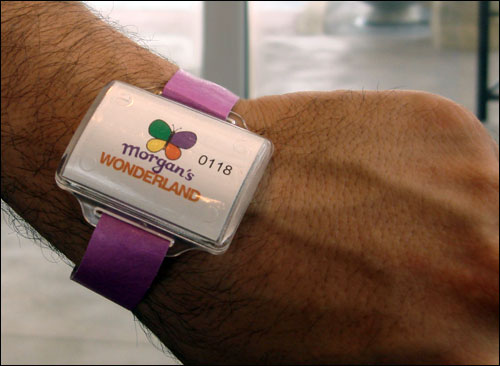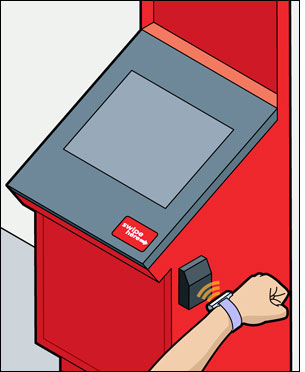When families go to Morgan’s Wonderland, a San Antonio, Texas, theme park devoted to children or adults with physical or mental disabilities, the park already knows something about them—including their health needs and allergies, the names of the people accompanying them, and an e-mail address for sending pictures of their time on-site. With the use of an RFID-enabled bracelet, visitors can share that information with park employees as needed, automatically. The park installed the system to better provide for the safety and comfort of its special-needs guests.
The park includes attractions such as the Sensory Village with themed spaces—a grocery store and TV station, for instance—built around an indoor streetscape intended to provide sensory stimulation. The Butterfly Playground has wheelchair-accessible playground equipment, and there is also an amphitheater, an off-road vehicle ride and a carousel.
Morgan’s Wonderland is owned by Sports Outdoor and Recreation (SOAR), a nonprofit organization established by the Gordon Hartman Family Foundation to manage Morgan’s Wonderland and the South Texas Area Regional Soccer Complex (STAR). The 25-acre theme park, which first opened its doors in April 2010, is the first of its kind to specialize in entertainment for those with special needs, according to the company. Its operation is funded by contributions, as well as proceeds from STAR. Each special-needs individual can enter the park for free, and family members without special needs pay $5 each. Those attending without a special-needs guest pay $15 per person.
When establishing the park, SOAR met with family members, who indicated they needed a park at which special-needs individuals would feel safe and comfortable, says Peter Albarian, the director of Morgan’s Wonderland. That meant limiting the number of visitors at the park at any given time, in order to reduce crowds, noise and lines, as well as make it possible to easily track the location of all members of a particular group. The solution was an online registration system that reserves tickets for pending visitors, and also gains information regarding those individuals, that is then forwarded to an RFID system known as Location Station, provided by RFIDTec, a California integrator and software provider.
The system uses several RFID tags embedded in a single wristband, and RFID interrogators installed throughout the park, as well as RFID kiosks, to help visitors keep track of their party by reading their own ID bracelet and accessing a screen showing where the others are located. The system also helps ensure that no one leaves the park with a non-group member, because handheld RFID readers at the gate issue an alert if anyone attempts to leave without their full party, and allows photos of the visitors interacting at the park to be e-mailed directly to them when those individuals scan their RFID tags to call up their e-mail address.
The park sets a maximum number of visitors at any particular time, Albarian says, to keep the crowds under control. It expects that number to be approximately 1,700, he notes, adding that the park plans to adjust that maximum as it determines the level of noise, lines and crowding it may create. To control the numbers of visitors at any given time, the park employs an online registration process provided by San Antonio software consultancy Denim Group. Those registering can create an account, select the date on which they wish to visit, and then input information about themselves or their family members if they so choose, such as health issues that they would like the park to be aware of, explains Sheridan Chambers, Denim Group’s principal and cofounder —for example, if a child has a specific food allergy, is diabetic or is prone to seizures. The Denim registration software then stores that information, enabling a user to print a bar-coded reservation ticket that he or she can then take to the park on the date of the visit.
When visitors arrive at the park, their printed bar-code tickets are scanned, and the registration data is listed on a computer screen. Workers then provide each member of the group with an RFIDTec Locator wristband, about the size of a watch. The wristband contains three RFID tags: one active RF Code 433 MHz RFID tag for location purposes, and two passive tags—a high-frequency (HF) 13.56 MHz tag provided by ViVOtech , and a low-frequency (LF) 135 kHz tag from Texas Instruments. The HF tag is designed to be read at close proximities at the exit and registration area, as well as at Location Station kiosks. The LF tag—which, due to the readers’ antenna array, has a longer read range than the HF tag with handheld readers, and requires less precision in placing the wristband by the interrogator—is used by the visitors to have photos e-mailed to them. Each of a wristband’s three tags is encoded with a different unique ID number, and all three IDs are linked to another unique identifier for the wristband itself. RFIDTec’s Location Station software then links the wristband ID numbers to the guest’s registration data.
The park has installed 33 RF Code 433 MHz readers, to create 33 separate zones within the site. At any given time, anyone in the park is within read range of one of the interrogators. The active tag in the wristband transmits to the reader with a read range of between 50 and 400 feet, depending on how the interrogators are adjusted to receive those transmissions, based on their location within the park and their nearness to other readers. That location information, says Eric Couch, RFIDTec’s chief architect, is then forwarded to the Safety Zone software on the park’s back-end system via a cabled connection.
If a group’s leader loses someone from his party, he can visit one of five RFID-enabled kiosks installed around the park. At the kiosk, he places his wristband within range of a reader, which reads the wristband’s passive HF tag. The software then pulls up the ID numbers for all members in his group, and displays the location of each person as named icons on a displayed map of the site, shown on the kiosk monitor.
At some exhibits, such as a simulated newsroom, visitors can have their pictures taken and e-mailed to them. In this case, a visitor taps his or her wristband near an RFID reader, and the passive LF tag is read and linked to an e-mail address provided at the time of registration. The park’s staff can then send the picture to that address.
In case an individual requires help, several employees carry handheld RFID interrogators. In such an event, they can read that person’s passive HF tag and view a display listing his or her name, along with any medical information input at the time of registration.
When guests leave the park, their wristbands are read with handheld HF interrogators a final time, and the Denim software verifies that all members of that group are present before the wristbands are returned to the park’s staff and the guests are allowed to exit. The wristbands are then cleaned and later reassigned to subsequent visitors.
“People have told us, ‘This is amazing—how does it work?'” Albarian says. The RFID system, he adds, “is one of the things that makes families feel at ease. These kids are enjoying themselves in the park, and parents are able to relax without worrying about their child.”



